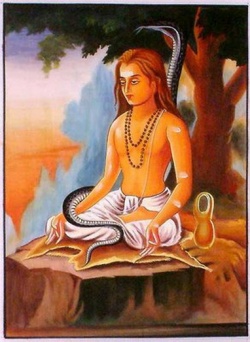Nagas
Revision as of 04:05, 14 September 2013 by Adminos (talk | contribs) (Text replacement - "Category:Nāgas" to "Category:Nagas")
- Ah, young mortal, so nice to see you again. So far I have told you about Y Ddraig Gosh, the Red Dragon of Wales, and Fafnir, the greedy Norse dwarf who became a dragon. Today I am going to tell you about a race of dragons from India called nagas. Nagas do not look like me or either of the previous dragons I have mentioned. Instead, nagas look like the hooded cobra, though they can vary greatly in size and have many heads. Nagas can also take on human forms as well as hybrid forms. Nagas are seen as deities in both Hinduism and Buddhism. They are also seen as nature spirits and are closely associated with water rather than with fire like we dragons of the West. Also, unlike many western dragons, nagas are usually quite benevolent - unless they are mistreated. Something that we do have in common is the protecting of treasure.
- In Hinduism, one very important naga is Shesha, the king of the nagas. Shesha is one of the first beings ever created and he holds the entire universe on his many hoods. According to Hindu texts, Shesha is an avatar of the divine power Sankarshana. He is also a loyal servant of the god Vishnu. Shesha has followed Vishnu through many incarnations, or lives, and has been his loyal companion. Vishnu has taken on various forms in order to protect humans and the world. When Vishnu took on the avatar of the Indian hero Rama, Shesha took on the avatar of Rama’s brother Lakshmana so that he could stay with him and assist him. When Vishnu took on the avatar of Krishna, Shesha took on the avatar of Krishna’s brother Balarama. Such loyalty is extremely different from the deception and selfishness in the story of Fafnir, is it not? Though we are all dragons, we are all very different, just like you humans.
- The Hindu God Vishnu and his consort Lakshmi resting on Sheshnag. Source: Mesosyn.
- Two other important Hindu nagas are Manasa and her brother Vasuki. Manasa is the Hindu goddess of snakes. She is associated with fertility and prosperity and she is also capable of curing snakebites. Manasa’s mother is Kadru, the mother of all nagas, and her father is recognized as Kadru’s husband, the sage Kashyapa, though it is also believed that the god Shiva is Manasa’s father. Vasuki, on the other hand, is a naga king who allowed the gods and demons to use him as a churning rope in order to churn the ocean of milk and extract the nectar of life. Vasuki, as well as other nagas, is also a worshiper and protector of the Buddha, who is said to be yet another avatar of Vishnu.
- An important naga in Buddhism is the naga king Mucalinda, who protected the Buddha from the elements for seven days by sheltering him with his hood. It is widely believed that the Buddha was an avatar of Vishnu. Many also believe that Mucalinda was an avatar of Shesha. According to the Mahayanists, followers of one sect of Buddhism, there are four classes into which nagas can be placed. The Heavenly Nagas are guardians of the heavenly palace. The Divine Nagas control the clouds and the rain. The Earthly Nagas control the rivers. Lastly, there are the Hidden Nagas who guard treasure.
- Along with Buddhism, the nagas spread out towards China, Tibet, and other Asian countries. Because of this, the dragons of China and Japan are closely related with the nagas of India, but I will tell you more about this next time. Until then, young mortal.
- The Naga King Mucalinda sheltering the Buddha. Source: The illustrated life of the Lord Buddha!
- Author’s Note: I used information from Sacred Texts Archive and Wikipedia. I wanted to go into more information on Shesha, but I have a feeling I would have gotten off track, and I wanted to make this a general overview of the nagas and feature a few different ones. I’ve actually studied Buddhism on and off for a few years, but until really looking at the nagas, I had never heard of Mucalinda. I also hadn’t realized how many nagas there are in Chinese and Japanese dragon lore. I have some dragons I’m focusing on for China and Japan, but there may be a naga in there now too. I think it’s interesting how Western dragons are usually huge malevolent fire-breathers with wings and claws while the Eastern dragons look like cobras, humans, or a mix, are associated with water, and are kind unless they are mistreated. They’re so different, yet they are all dragons. I guess it’s the same with humans though. The image of Vishnu and Lakshmi resting on Shesha is extremely popular. On the image information, it refers to Shesha as Sheshnag. I’ve noticed that the final ‘a’ is left off sometimes, but from my understanding, Sheshnag is a contracted version of Shesha and naga.
